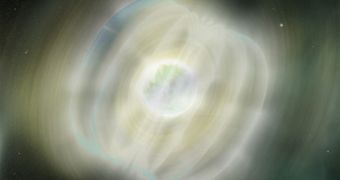At a recent conference, a team of researchers presented new discoveries showing that a special class of of neutron stars, called fast-spinning magnetars, is responsible for a large part of all gamma-ray bursts (GRB) that have been noticed in the Universe thus far.
Experts knew that the structures are involved, but until now they thought that magnetars accounted for only a small portion of all observed GRB. The bursts are the most energetic most luminous electromagnetic events known to exist in the Cosmos.
It's been about two decades since the international astronomical community has been locked in a debate as to the sources for these GRB, given that there are very few types of objects in the Universe that can emit so much radiation at such large energy levels.
It would now appear that magnetars are not only capable of doing so, but that they in fact account for a much larger swath of all GRB than astrophysicists had originally calculated, Science News reports.
Details of the new investigation were presented in front of scientists and reporters gathered at the Gamma Ray Burst 2010 meeting, on November 3.
The team that made the announcement said that the fast spinning magnetars generate the most intense and strong magnetic fields in the known Universe, and added that these field may be the powerhouse driving a large portion of GRB.
In the past, experts have argued that long gamma-ray bursts were produced by magnetars that remained stable for only several minutes before collapsing in on themselves, giving birth to black holes.
The GRB created in this manner can endure for up to two seconds, which is a lot of time for an event of this magnitude and intensity.
But the new set oc calculations showed that magnetic fields around magnetars can also be used to account for the creation of short GRB, which last for milliseconds. This particular type of bursts accounts for about 10 percent of all GRB noticed in the Cosmos until now.
According to Harvard University astrophysicist Edo Berger, more data are needed before experts can determine the amount of energy gamma-ray bursts carry. Knowing this with great precision can in the end indicate if a magnetar or a black hole is powering the GRB.
The expert adds that this may happen as early as next year, when an upgraded version of the Socorro, New Mexico-based Very Large Array radio telescope will be used to look for the sources of GRB.
Berger will be in charge of that research effort, and details will be published in a specialized journal.

 14 DAY TRIAL //
14 DAY TRIAL //